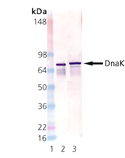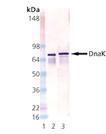Product Details
| Alternative Name: | Hsp70 |
| |
| Clone: | 8E2/2 |
| |
| Host: | Mouse |
| |
| Isotype: | IgG1 |
| |
| Immunogen: | E. coli DnaK. |
| |
| UniProt ID: | P0A6Y8 (strain K12) |
| |
| GenBank ID: | AP009048 |
| |
| Source: | Purified from ascites. |
| |
| Species reactivity: | E. coli
|
| |
| Applications: | WB
|
| |
| Recommended Dilutions/Conditions: | Western Blot (1:10,000)
Suggested dilutions/conditions may not be available for all applications.
Optimal conditions must be determined individually for each application. |
| |
| Application Notes: | Detects a band of ~70kDa by Western blot. |
| |
| Purity Detail: | Protein G affinity purified. |
| |
| Formulation: | Liquid. In PBS, pH 7.2, containing 50% glycerol and 0.09% sodium azide. |
| |
| Handling: | Avoid freeze/thaw cycles. |
| |
| Shipping: | Blue Ice |
| |
| Long Term Storage: | -20°C |
| |
| Scientific Background: | DnaK possesses an autophosphorylation activity and a weak 5-nucleotidase activity, cleaving the 5 phosphate groups from both ribose and deoxyribose nucleotides. The role of DnaK in ATP-dependent protein-protein interactions has been extended to normal E. coli physiology, where, like eukaryotic Hsp70 homologs, it is thought to participate in the assembly/disassembly of protein complexes. |
| |
| Regulatory Status: | RUO - Research Use Only |
| |

Western blot analysis: Lane 1: MW Marker, Lane 2: DnaK active recombinant protein (Prod. No. ADI-SPP-630), Lane 3: E. coli cell lysate.
Please mouse over
Product Literature References
Genetic Programming by Nitric Oxide-Sensing Gene Switch System in Tumor-Targeting Bacteria: Y. Qin, et al.; Biosensors
13, 266 (2023),
Abstract;
Transcriptional insight into the effect of benzalkonium chloride on resistance and virulence potential in Salmonella Typhimurium: S. Park & H. Yoon; Microbiol. Res.
266, 127240 (2023),
Abstract;
Breaking antimicrobial resistance by disrupting extracytoplasmic protein folding: R.C.D. Furniss, et al.; Elife
11, e57974 (2022),
Abstract;
Regulation of oxidative stress and inflammatory responses in human retinal pigment epithelial cells: N. Harju, et al.; Acta Ophthalmol.
100 Suppl 273, 3 (2022),
Abstract;
The expression of aminoglycoside resistance genes in integron cassettes is not controlled by riboswitches: A. Hipólito, et al.; Nucleic Acids Res.
50, 8566 (2022),
Abstract;
A Nitrogen Metabolic Enzyme Provides Salmonella Fitness Advantage by Promoting Utilization of Microbiota-Derived Carbon Source: W. Yoo, et al.; ACS Infect. Dis.
10, 1021 (2021),
Abstract;
hns mRNA downregulates the expression of galU and attenuates the motility of Salmonella enterica serovar Typhi: Z. Xin, et al.; Int. J. Med. Microbiol.
311, 151525 (2021),
Abstract;
Deciphering the possible role of ctxB7 allele on higher production of cholera toxin by Haitian variant Vibrio cholerae O1: A. Naha, et al.; PLoS Negl. Trop. Dis.
14, 4 (2020),
Abstract;
Full Text
Recombinant production of ESAT-6 antigen in thermoinducible Escherichia coli: the role of culture scale and temperature on metabolic response, expression of chaperones, and architecture of inclusion bodies: S. Restrepo-Pineda, et al.; Cell Stress Chaperones
24, 777 (2019),
Abstract;
Comparison of Salmonella enterica serovars Typhi and Typhimurium reveals typhoidal-specific responses to bile: R. Johnson, et al.; Infect. Immun.
86, e00490 (2018),
Abstract;
Full Text
Molecular basis for CesT recognition of type III secretion effectors in enteropathogenic Escherichia coli: D. J. Little, et al.; Plos Pathog.
14, e1007224 (2018),
Abstract;
Full Text
Role of a single noncoding nucleotide in the evolution of an epidemic African clade of Salmonella: D.L. Hammarlof, et al.; PNAS
115, E2614 (2018),
Abstract;
Full Text
Identification of New Virulence Factors and Vaccine Candidates for Yersinia pestis: J.A. Andersson, et al.; Front. Cell. Infect. Microbiol.
7, 448 (2017),
Abstract;
Full Text
Influence of Escherichia coli chaperone DnaK on protein immunogenicity: R.D. Ratanji, et al.; Immunology
150, 343 (2017),
Abstract;
Full Text
Klebsiella pneumoniae Carbapenemase-2 (KPC-2), Substitutions at Ambler Position Asp179, and Resistance to Ceftazidime-Avibactam: Unique Antibiotic-Resistant Phenotypes Emerge from β-Lactamase Protein Engineering: M.D. Barnes, et al.; Mbio
8, e00528 (2017),
Abstract;
Full Text
Reductive evolution in outer membrane protein biogenesis has not compromised cell surface complexity in Helicobacter pylori: C.T. Webb, et al.; Microbiologyopen
6, e00513 (2017),
Abstract;
Full Text
Salmonella exploits the host endolysosomal tethering factor HOPS complex to promote its intravacuolar replication: A. Sindhwani, et al.; PLoS Pathog.
13, e1006700 (2017),
Abstract;
Full Text
The malS-5’UTR regulates hisG, a keygene in the histidine biosynthetic pathway in Salmonella enterica serovar Typhi: Y. Zhang, et al.; Can. J. Microbiol.
63, 287 (2017),
Abstract;
The role of the FliD C-terminal domain in pentamer formation and interaction with FliT: H.J. Kim, et al.; Sci. Rep.
7, 4418 (2017),
Abstract;
Full Text
The type III secretion system effector SptP of Salmonella enterica serovar Typhi: R. Johnson, et al.; J. Bacteriol.
199, e00647 (2017),
Abstract;
Full Text
Analysis of Salmonella PhoP/PhoQ regulation by dimethyl-SRM-based quantitative proteomics: L.Z. Hu, et al.; Biochim. Biophys. Acta
1864, 20 (2016),
Abstract;
Bacterial Hsp70 (DnaK) and mammalian Hsp70 interact differently with lipid membranes: V. Lopez, et al.; Cell Stress Chaperones
21, 609 (2016),
Abstract;
Full Text
Fine-tuning of amino sugar homeostasis by EIIA(Ntr) in Salmonella Typhimurium: W. Yoo, et al.; Sci. Rep.
6, 33055 (2016),
Abstract;
Full Text
Heterologous Expression of Thermolabile Proteins Enhances Thermotolerance in Escherichia coli: Y. Ueda, et al.; Adv. Microbiol.
6, 602 (2016),
Application(s): Western blot analysis,
Full Text
Intracellular Salmonella induces aggrephagy of host endomembranes in persistent infections: N. Lopez-Montero, et al.; Autophagy
12, 1886 (2016),
Abstract;
Full Text
Missing the target: DNAk is a dominant epitope in the humoral immune response of channel catfish (Ictalurus punctatus) to Flavobacterium columnare: M.D. Lange, et al.; Fish Shellfish Immunol.
51, 170 (2016),
Application(s): 1-D gel electrophoresis and western blot analyses,
Abstract;
The effects of cytotoxic necrotizing factor 1 expression in the uptake of Escherichia coli K1 by macrophages and the onset of meningitis in newborn mice: A.C. Chang, et al.; Virulence
7, 806 (2016),
Abstract;
Full Text
Activity of a Bacterial Cell Envelope Stress Response is Controlled by the Interaction of a Protein-binding Domain with Different Partners: J. Flores-Kim, et al.; J. Biol. Chem.
290, 11417 (2015),
Application(s): Western Blot,
Abstract;
Full Text
CCR2+ Inflammatory Dendritic Cells and Translocation of Antigen by Type III Secretion Are Required for the Exceptionally Large CD8+ T Cell Response to the Protective YopE69-77 Epitope during Yersinia Infection: Y. Zhang, et al.; PLoS Pathog.
11, e1005167 (2015),
Application(s): Immunoblotting,
Abstract;
Full Text
Chimeric adaptor proteins translocate diverse type VI secretion system effectors in Vibrio cholerae: D. Unterweger, et al.; EMBO J.
34, 2198 (2015),
Abstract;
Full Text
Further characterization of a highly attenuated Yersinia pestis CO92 mutant deleted for the genes encoding Braun lipoprotein and plasminogen activator protease in murine alveolar and primary human macrophages: C.J. van Lier, et al.; Microb. Pathog.
80, 27 (2015),
Application(s): Western Blotting,
Abstract;
Influence of gamma irradiation on expressed heat shock proteins of Pantoea agglomerans, a yellow pigmented phytopathogen: D. Dussault, et al.; Microbiol. Res. Int.
3, 51 (2015),
Application(s): Western Blot,
Full Text
Novel HSP90 inhibitors effectively target functions of thyroid cancer stem cell preventing migration and invasion: P.T. White, et al.; Surgery
159, 142 (2015),
Application(s): Western blot,
Abstract;
Overexpression, Purification and Characterisation of the Plasmodium falciparum Hsp70-z (PfHsp70-z) Protein: T. Zininga, et al.; PLoS One
10, e0129445 (2015),
Application(s): Western Blot,
Abstract;
Full Text
Shigella flexneri Regulation of ARF6 Activation during Bacterial Entry via an IpgD-Mediated Positive Feedback Loop: A.C. Garza-Mayers, et al.; MBio.
6, e02584 (2015),
Application(s): SDS-PAGE,
Abstract;
Full Text
Scope and limitations of the designer proline-rich antibacterial peptide dimer, A3-APO, alone or in synergy with conventional antibiotics: J.r. Otvos, et al. ; Peptides
29, 1878 (2008),
Application(s): WB using bacteria purified protein,
Abstract;
TLR4-mediated activation of dendritic cells by the heat shock protein DnaK from Francisella tularensis: S. Michalek, et al. ; J. Leukoc. Biol.
84, 1434 (2008),
Application(s): WB using bacteria cell lysates,
Abstract;
An essential role for the DnaK molecular chaperone in stabilizing over-expressed substrate proteins of the bacterial twin-arginine translocation pathway: M. DeLisa, et al. ; J. Mol. Biol.
367, 715 (2007),
Application(s): WB using bacteria cell lysates,
Abstract;
Decline in ribosomal fidelity contributes to the accumulation and stabilization of the master stress response regulator σ(S) upon carbon starvation: T. Nystroem, et al. ; Genes Dev.
21, 862 (2007),
Application(s): WB using bacteria cell lysates,
Abstract;
Escherichia coli heat shock protein DnaK: production and consequences in terms of monitoring cooking: L. Saucier, et al. ; Appl. Environ. Microbiol.
69, 3231 (2003),
Application(s): EIA using bacteria (E. coli) samples,
Abstract;
Secretin of the enteropathogenic Escherichia coli type III secretion system requires components of the type III apparatus for assembly and localization: B.B. Finlay, et al. ; Infect. Immun.
71, 3310 (2003),
Application(s): WB using bacteria (E. coli) samples,
Abstract;
Salmonella effectors within a single pathogenicity island are differentially expressed and translocated by separate type III secretion systems: B.B. Finlay, et al. ; Mol. Microbiol.
43, 1089 (2002),
Application(s): WB using bacteria (Salmonella) samples,
Abstract;
Adaptive and cross-protective responses of Pseudomonas sp. DJ-12 to several aromatics and other stress shocks: C.K. Kim, et al. ; Curr. Microbiol.
43, 176 (2001),
Application(s): WB using bacteria (porcineseudomonas) samples,
Abstract;
Detection of stress proteins in Porphyromonas gingivalis and other oral bacteria by Western immunoblotting analysis: D. Grenier, et al. ; FEMS Microbiol. Lett.
121, 303 (1994),
Application(s): WB using bacteria (Actinomyces, Capnocytophaga sp.) samples,
Abstract;
Related Products










